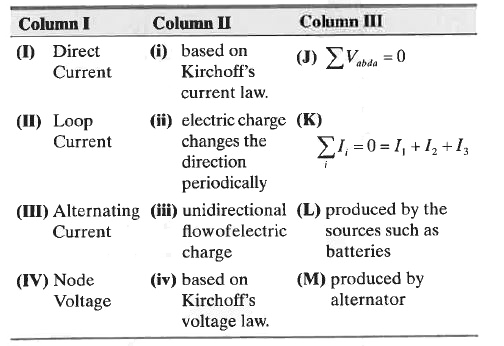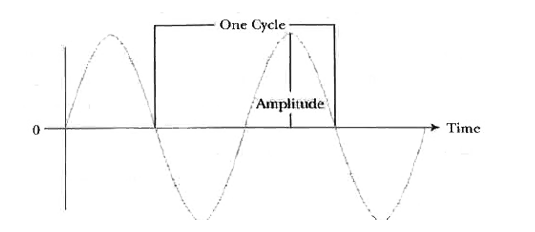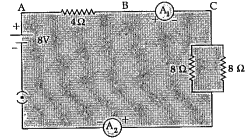Electrical current is the flow of charged particles. The electric current flows through a wire the same way as how water moves in a river. The electricity is nothing but the flow of electrons. There are two main combinations of resistors in circuit, that is series and parallel. In the given table, Column I shows different combinations of resistors, Column II shows voltages of different arrangements of resistors and Column III shows currents and voltage division needed or not in different arrangements of resistors.
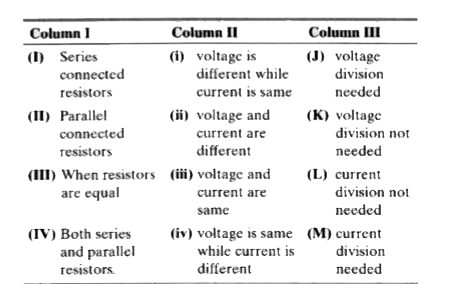
When does the voltage division problem arise?
(I) (i) (J)
(IV) (i) (M)
(III) (ii) (L)
(I) (iii) (L)
The correct Answer is:A
Step by step video, text & image solution for Electrical current is the flow of charged particles. The electric current flows through a wire the same way as how water moves in a river. The electricity is nothing but the flow of electrons. There are two main combinations of resistors in circuit, that is series and parallel. In the given table, Column I shows different combinations of resistors, Column II shows voltages of different arrangements of resistors and Column III shows currents and voltage division needed or not in different arrangements of resistors. When does the voltage division problem arise? by Physics experts to help you in doubts & scoring excellent marks in Class 12 exams.
Topper's Solved these Questions
- BOOK - RESNICK AND HALLIDAYCHAPTER - CIRCUITSEXERCISE - Practice Questions (Integer Type)3videos
CIRCUITS
- BOOK - RESNICK AND HALLIDAYCHAPTER - CIRCUITSEXERCISE - Practice Questions (Linked Comprehension)11videos
CIRCUITS
- BOOK - RESNICK AND HALLIDAYCHAPTER - CENTER OF MASS EXERCISE - Practice Questions (Integer )4videos
CENTER OF MASS
- BOOK - RESNICK AND HALLIDAYCHAPTER - CIRCULAR MOTIONEXERCISE - CHECK POINTS6videos
CIRCULAR MOTION
Similar Questions
Knowledge Check
- Question 1 - Select One
Electrical current is the flow of charged particles. The electric current flows through a wire the same way as how water moves in a river. The electricity is nothing but the flow of electrons. There are two main combinations of resistors in circuit, that is series and parallel. In the given table, Column I shows different combinations of resistors, Column II shows voltages of different arrangements of resistors and Column III shows currents and voltage division needed or not in different arrangements of resistors.
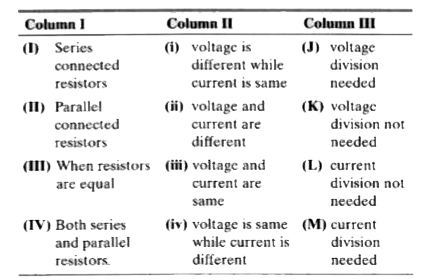
When does the current division problem arise?A(III) (i) (K)B(IV) (i) (J)C(III) (iii) (M)D(II) (iv) (M) - Question 2 - Select One
Electrical current is the flow of charged particles. The electric current flows through a wire the same way as how water moves in a river. The electricity is nothing but the flow of electrons. There are two main combinations of resistors in circuit, that is series and parallel. In the given table, Column I shows different combinations of resistors, Column II shows voltages of different arrangements of resistors and Column III shows currents and voltage division needed or not in different arrangements of resistors.
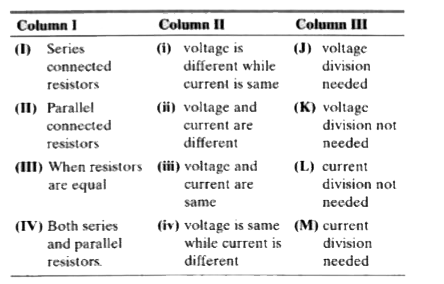
When there is no voltage division problem arise?A(II) (iv) (K)B(IV) (i) (M)C(III) (ii) (L)D(III) (iv) (K) - Question 3 - Select One
Electrical current is the flow of charged particles. The electric current flows through a wire the same way as how water moves in a river. The electricity is nothing but the flow of electrons.
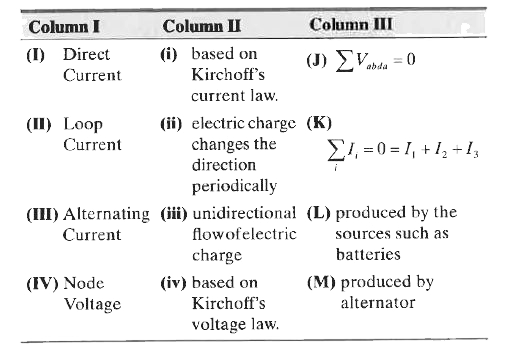
What does the graph signify?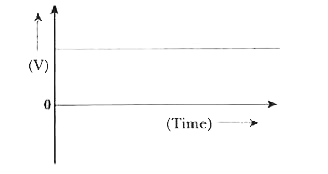 A(II) (iv) (J)B(IV) (i) (M)C(I) (ii) (L)D(III) (iv) (K)
A(II) (iv) (J)B(IV) (i) (M)C(I) (ii) (L)D(III) (iv) (K)
Electrical current is the flow of charged particles. The electric current flows through a wire the same way as how water moves in a river. The electricity is nothing but the flow of electrons.
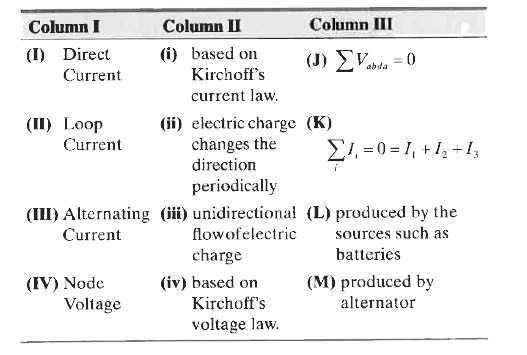
What does the circuit diagram signify? View Solution
View SolutionElectric current can flow through
View SolutionThere are mainly two types of combinations of resistors in a circuit, series and parallel. In the given table, Column I shows voltages of different arrangements of resistors, Column II shows different arrangement of resistors and Column III shows currents of different arrangements of resistors.
What are the conditions when resistor is in the parallel network?
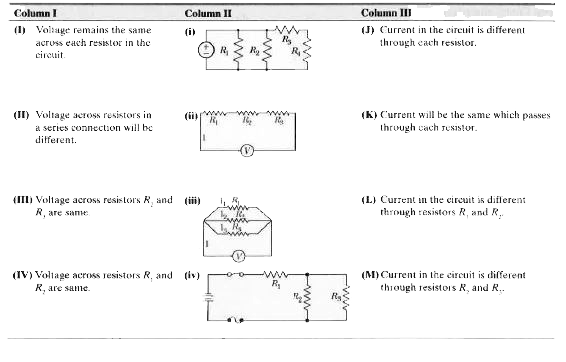 View Solution
View SolutionThere are mainly two types of combinations of resistors in a circuit, series and parallel. In the given table, Column I shows voltages of different arrangements of resistors, Column II shows different arrangement of resistors and Column III shows currents of different arrangements of resistors.
What are the conditions when resistors are in mixed combination, that is series and parallel combination respectively?
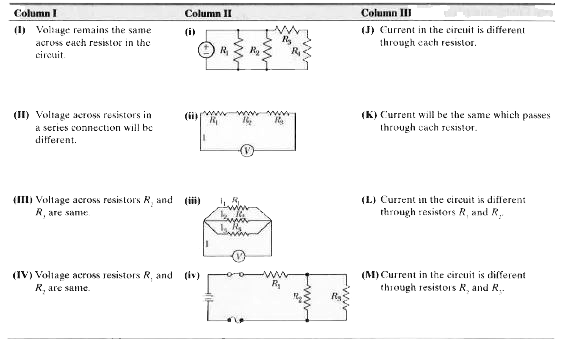 View Solution
View SolutionThere are mainly two types of combinations of resistors in a circuit, series and parallel. In the given table, Column I shows voltages of different arrangements of resistors, Column II shows different arrangement of resistors and Column III shows currents of different arrangements of resistors.
What are the conditions when resistors are in mixed combination, that is, parallel and series combination respectively?
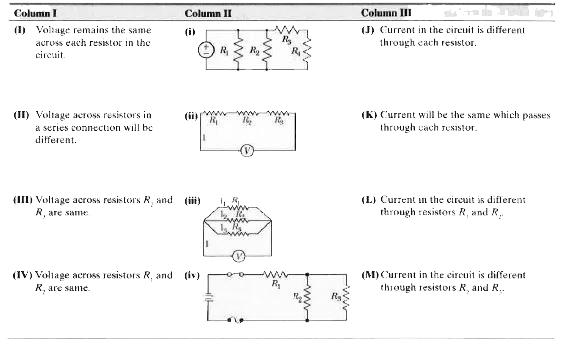 View Solution
View Solution


